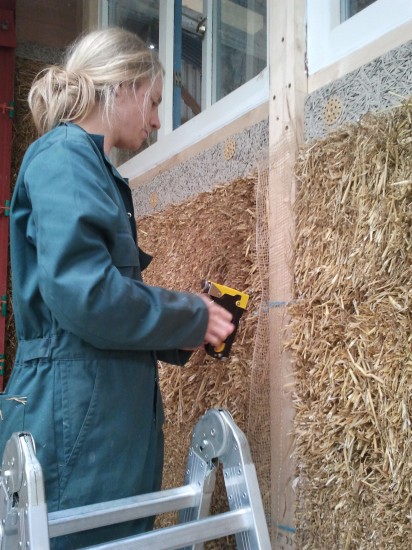4 – Prepare the walls
Prepare the plaster grounds (the walls)
Assuming we are talking strawbale walls, they will need trimming – it is worth trying to get them as straight as you can before starting, and making any rounded edges and contours you want. We found a chainsaw was good for getting rid of large chunks and a hedge cutter for getting a good overall straight finish. We’ve seen people using angle grinders with a wood carving attachment, and super sharp hand shears too. We saved the straw from the trimming for mixing in the plaster later along with other saved up straw from the building process, the stuff goes everywhere, so worth collecting it as you go.
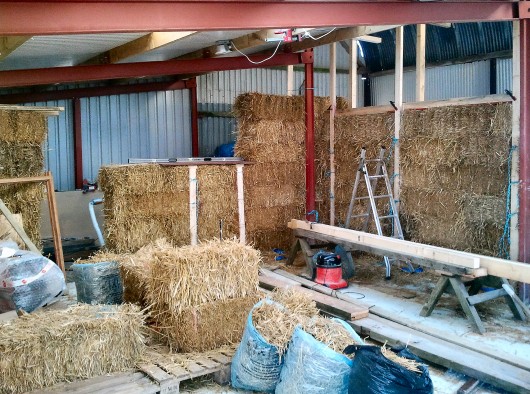
The usual advice is to stuff all the gaps and holes with straw before starting, which we did. However, to a large extent we found they came loose again when we starting slapping on the slip coat. Hence we ended up dipping wadges of straw in slip as we came across the holes and gaps when doing the first coat.
Install services like electric wires and sockets:
Wire up the electrics, it is easier now than making lots of holes in your lovely plaster work later. Electricians apparently tend to draw a blank and/or do a poor job here because they are unaccustomed to straw bale construction. A few tips for your electrician may be:
* Use the horizontal joint lines of the bales to route cables – a smooth ended stick can be used to push the cable a few inches into the wall.
* For vertical cable runs cut a groove with the chainsaw, and again, just carefully press the cable in there.
* Insist they use generous cable sizes, so there isn’t a problem with overheating of cables embedded in the straw.
Sockets and Light Switches:
It’s a good idea to install the back boxes for sockets and switches before you put on your first coat. they want to be mounted in the straw so they stick out about one inch, so the finished plaster comes flush. In our climate (UK) we think it is sensible to try and minimise the amount of metal in the wall, which could potentially form a cold surface that condensation can form on, and crate dampness in the wall (bad!). Thus, we used plastic dry lining boxes, for light switches and sockets in the straw bale wall.
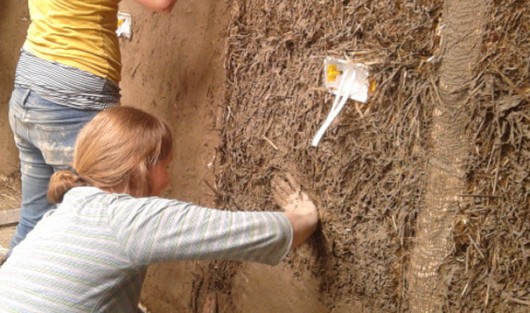
Install the dry lining boxes into the wall by cutting out a little rectangle with the chainsaw for the box itself, then plunge cut the saw in about ¾ the way through (make sure you are not going to cut any bale strings!) in the middle of you rectangle. This plunge cut ‘self seals’ when you retract the saw, but forms a guide hole for a timber wedge, which you can hammer in. The dry lining box can then be nestled into the rectangle and screwed to the timber wedge. This should then all be reasonably firm in the wall and adjusted to the correct level.
To maintain the excellent fire resistance of the wall, the area behind the back box should be pre-coated in thick clay slip, making the area immediately behind the socket (where there will be no plaster), much more fireproof.
You can also cut neat holes, after the event, in the finished plaster, using a multi-tool, exactly as you would in plasterboard, like so:
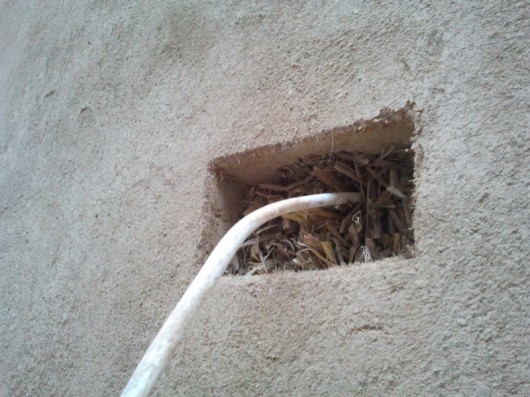
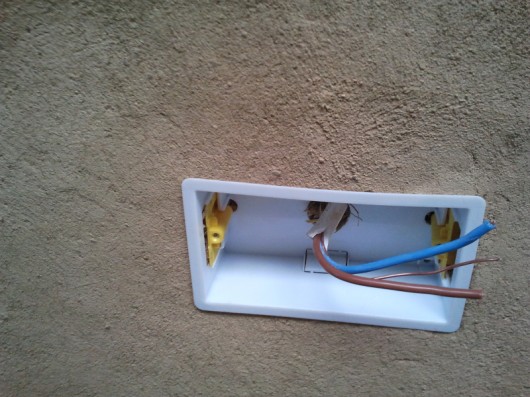
This second way of doing it, still requires the cable to be routed properly prior to plastering, and is slightly more fiddly (dry lining boxes are not generally designed for super thick plaster) and a little less secure because they are not ‘plastered in’.
Prep Timber
For any surfaces that aren’t straw, such as timber frame work, you’ll need to provide a ‘key’ for to help the plaster stick. We covered the timber up-rights with jute scrim, aka burlap or hessian webbing. We used stainless steel staples to attach it, standard steel is likely to corrode badly during the clay drying time. There were also a number of areas where timber needed covering up but wasn’t at the same level as the rest of the straw wall. We used ‘wood wool’ to bulk these areas out and provide a key for the plaster at the same time. All this will depend a lot on the construction and how you want it to look afterwards though. (You can find a little advantages and disadvantages of wood wool pondering in this post).
